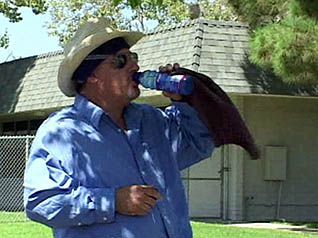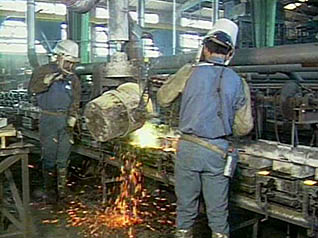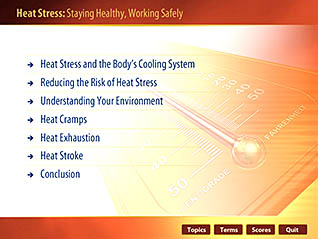Heat Stress: Staying Healthy, Working Safely
- Product ID
- wumbhshs
- Training Time ?
- 58 to 116 minutes
- Language(s)
- English,Spanish
- Video Format
- Standard Definition
- Required Plugins
- MasteryNet Player
- Lesson Interactions
- 16
- Quiz Questions
- 33
- Closed Captioning



Overexposure and overexertion to high temperatures can lead to heat cramps, heat exhaustion, and heat stroke. It also increases your liability for workplace incidents as workers become overheated, tired, and agitated. As a responsible business leader you benefit from providing your employees with safety equipment and safety policies. The U.S. Department of Labor and OSHA recommend you incorporate a heat stress training program to reduce this workplace hazard.
Adding this Advantage course to your resources gives employees the tools to take personal responsibility for their safety. Participants in this course will learn about the major risk factors and illnesses resulting from overexposure. Moreover, they will learn to reduce their risk of heat illness. Risk reduction methods include learning to dress, hydrate, and rest appropriately. Each lesson includes training assessment tools to ensure your employees are prepared to apply their knowledge in the field.
A multi-faceted heat safety program can protect your employees from illness and protect your business from the resulting claims and costs. It pays to stay healthy and work safely.
![]() This course is in the Advantage™ format, to read about Advantage™ features click here.
This course is in the Advantage™ format, to read about Advantage™ features click here.

- Rich multimedia presentation with interactions and quiz
- Print certificate and wallet card
- You have 30 days to complete the course
Any workers exposed to high temperatures, indoors or out. This course is especially applicable to agricultural and factory workers.
-
Heat Stress and the Body's Cooling System
- Normal body functioning
- Negative effects of overheating
-
Reducing the Risk of Heat Stress
- Dressing for the heat
- Hydration and dehydration
-
Understanding Your Environment
- Outdoor conditions
- Indoor conditions
- Additional risk factors
- Heat stress and heat-related illnesses
-
Heat Cramps
- Definition and cause of heat cramps
- Prevent or relieve heat cramps
-
Heat Exhaustion
- Definition and cause of heat exhaustion
- Symptoms of heat exhaustion
- Treatment of heat exhaustion
-
Heat Stroke
- Definition and cause of heat stroke
- Symptoms of heat stroke
- Treatment of heat stroke
-
Demonstrate an appreciation of heat stress hazards.
- Define heat stress.
- Identify normal body temperature.
- Identify how your body cools itself.
- Explain the ill effects if your body overheats.
-
Utilize proper clothing and hydration.
- Recognize suitable clothing for hot environments.
- Recognize inappropriate clothing for hot environments.
- Explain why rehydrating the body is so important.
- Identify proper types of fluids to drink in hot environments.
- Identify the amounts of fluid required to keep the body properly hydrated.
- Identify fluids to avoid when working in hot environments.
- Explain why certain fluids should be avoided.
- Identify a sign of proper hydration.
-
Take measures to minimize the dangers of hot environments.
- Differentiate dangerous outdoor conditions.
- Recognize when indoor conditions can be dangerous.
- Agree that both indoor and outdoor conditions can lead to heat-related illnesses.
- Recognize behaviors and conditions that may increase the risk of heat-related illness.
- Identify practices to reduce the risk of heat-related illness.
-
Follow recommended practices to prevent or relieve heat cramps.
- Define heat cramps.
- Identify the cause of heat cramps.
- Identify recommended practices to prevent heat cramps.
- Identify recommended practices to relieve heat cramps.
-
Follow recommended practices to safely treat heat exhaustion.
- Define heat exhaustion.
- Identify the cause of heat exhaustion.
- Recognize the signs and symptoms of heat exhaustion.
- Identify safe techniques to treat heat exhaustion.
- Recognize actions to avoid when treating heat exhaustion.
-
Respond correctly to a heat stroke emergency.
- Define heat stroke.
- Recognize the signs and symptoms of heat stroke.
- Agree that the first responses are to seek medical assistance and call 911.
- Choose the correct treatments while waiting for help.
© Mastery Technologies, Inc.


